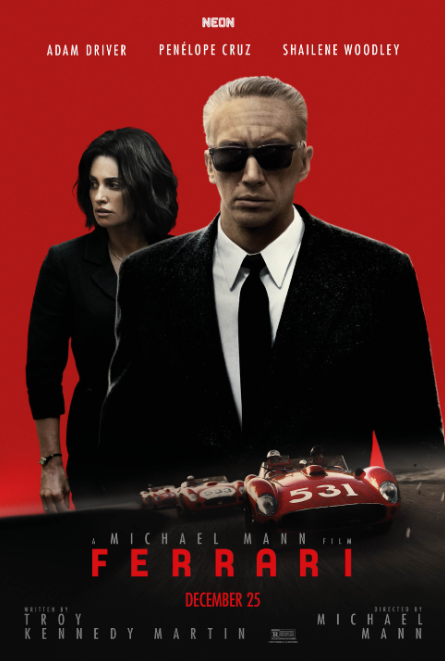'Ferrari' Review
Photo Courtesy: Neon
It is a bitter paradox that ‘Ferrari’ announced itself with scant grace and even less fanfare. Which is all the more ironic, too, given it represents the decades-long fulfilment of its creator’s childhood fascination. In its devastating rendering of the subject within a richly controlled narrative framework, ‘Ferrari’ delightfully rewards those willing to suspend their suspicions.
‘Ferrari’ takes place during the summer of 1957. We follow Enzo Ferrari as he navigates personal tumult amid the crumbling of his auto empire. The urgent need for his company to receive outside investment promises to be met in the eye-catching if treacherous 1,000-mile race through central Italy, the Mille Miglia. As is so often the case, personal problems arise in tandem with this acute professional crisis. Ferrari struggles to comfort his grieving wife, Laura, while attending to his wartime mistress, Lina, and their child. Throughout, Adam Driver evinces true star power, taking us as an audience through various meeting rooms and race practices yet never without dominating each space he occupies. Driver’s Enzo is someone who organises the world to fit his own prescribed template. It proves rich and fascinating.
The impulse behind this artistic decision is credited to its filmmaker, Michael Mann. Frustrated by the binary confines that afflict many biopics, Mann foresaw something special in the thrilling symmetry between beauty and grace so fittingly captured by Ferrari’s cars themselves. In a movie outwardly dedicated to a car and its founder, one is left with a feeling of real rage and dissatisfaction. Dissatisfaction at what is lost in the process, anger at the motivations behind a cruel eventuality. The delicate dance between the formality of assorted business dealings and the cruel law of driving laid bare by Enzo is as fascinating as it is distressing.
To report that the film was shot flawlessly would be to discredit the compelling realness of it all. Mann, adept at capturing the grit amid the glamour of Hollywood productions, effectively conveys the sheer physicality of the film’s subject throughout. It is telling that the opening scene’s closing of a car door and deft manipulation of gear shifts conveys the twin pillars of the film: sports film and moving drama. Although other filmmakers may focus more clearly on Enzo’s act of adultery as he departs his mistress in the early hours, Mann’s attentiveness to both sides of this relationship succinctly captures both why this is a movie about Ferrari and why that should matter.
It results in a meaningfully visceral experience. We are told that to drive a Ferrari race car comes with it a commitment to disown one’s right to life. It is no mere artistic indulgence to state that the movie is felt: in the roar of a car’s engine on a straight road, the grease that cloaks each race car driver, or the physicality of swinging a car around each ever-sharpening turn. It results in a thrilling tale that balances moments of quiet grace with moments of startling horror. Because, when all is said and done, very little separates our terrible joys from deadly passion.

